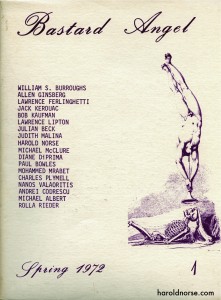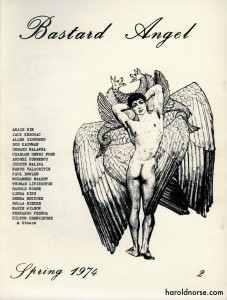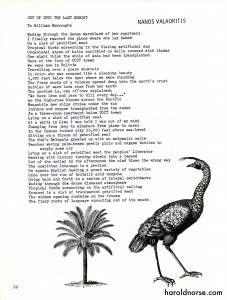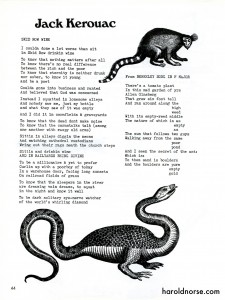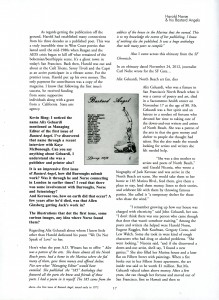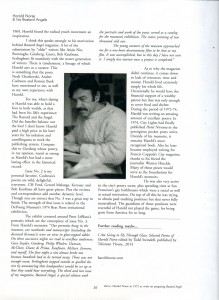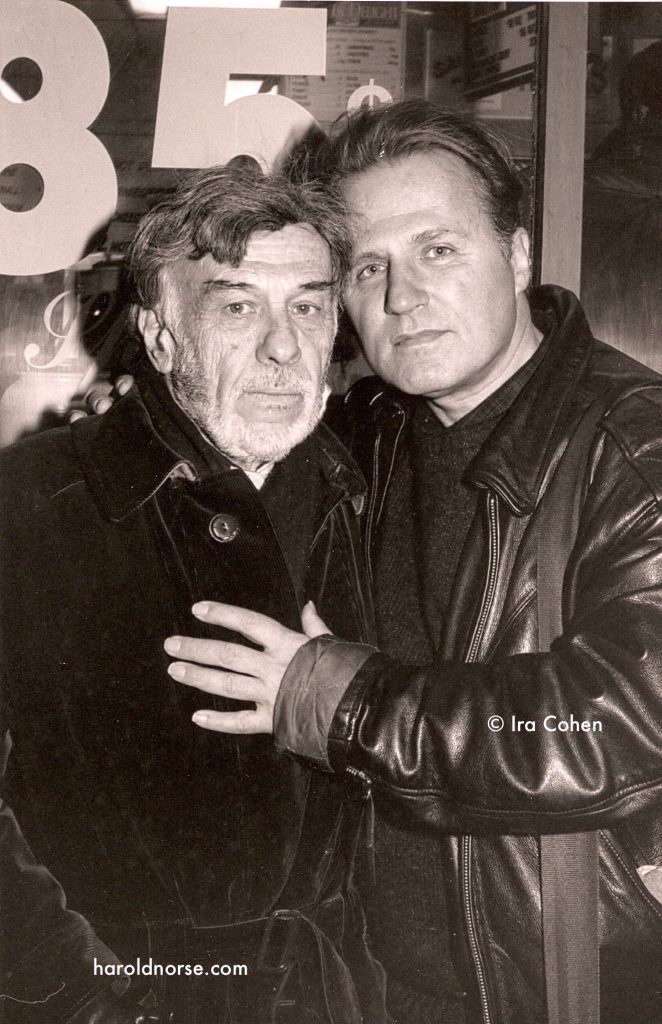This post takes a closer look at the participants in the second event celebrating the Harold Norse Centennial. On Saturday, July 9, the Beat Museum will host a panel including poet and writer Adrian Brooks, poet Jim Nawrocki and artist Tate Swindell. All three men were friends of Norse and will bring their personal remembrances to the evening’s discussion.
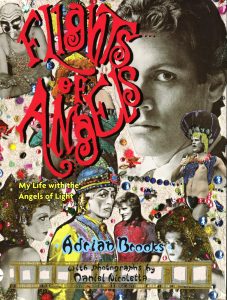 Adrian Brooks has a storied history from his Quaker upbringing, volunteering with Martin Luther King’s Southern Christian Leadership Conference, involvement in the New York arts scene of the late 1960s, then moving to San Francisco as part of gay liberation. Adrian became a member of the seminal performance troupe the Angels of Light which grew out of the equally legendary Cockettes.
Adrian Brooks has a storied history from his Quaker upbringing, volunteering with Martin Luther King’s Southern Christian Leadership Conference, involvement in the New York arts scene of the late 1960s, then moving to San Francisco as part of gay liberation. Adrian became a member of the seminal performance troupe the Angels of Light which grew out of the equally legendary Cockettes.
Flights of Angels: My Life with the Angels of Light is his memoir of that glittered encrusted period when gay liberation in San Francisco was a heady mixture of political, social and artistic movements. Illustrated with photographs by renowned gay photographer Daniel Nicoletta, Flights of Angels is required reading for those interested in radical gay performance in 1970’s San Francisco.
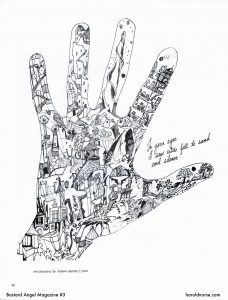 Here Brooks relates his initial contact with Harold–upon the suggestion of poet and photographer Gerard Malanga–which led to his involvement with Norse’s literary magazine Bastard Angel, recently profiled in the UK publication Beat Scene.
Here Brooks relates his initial contact with Harold–upon the suggestion of poet and photographer Gerard Malanga–which led to his involvement with Norse’s literary magazine Bastard Angel, recently profiled in the UK publication Beat Scene.
First, after being put in touch with novelist Christopher Isherwood, who liked my poems and invited me to visit him in Santa Monica, Gerard [Malanga] suggested I telephone a local Beat poet. At fifty-six, Harold Norse was a stumpy ex-bodybuilder with a bad toupee and a huge chip on his shoulder about being overlooked. I loved his earthy New York humor and ballsy work. I also appreciated his praise, and his invitation to serve as the editorial assistant for his cutting edge magazine, Bastard Angel, which featured surrealists and celebrities like Jean Genet, stellar Beats, and on occasion, up and coming “unknowns.”
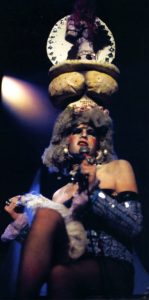
In a 2013 interview with Adrian about his friendship with Harold, I was impressed by his insight into Harold’s work and character–imbued with both criticism and compassion. Brooks was in a unique position at that time given his artistic expression straddled both the theatrical performance and poetry scenes.
On September 18, 1974, he organized what may be the first all-gay poetry reading at the Fellowship Church on Larkin Street. Among others, the roster included Norse, poet and publisher Paul Mariah, Pat Parker and Judy Grahn.
Here are some of Adrian’s reflections on the poetry scene at that time:
My perception of the Bay Area poetry cosmos was shaped by North Beach bars and coffeehouses like Café Trieste. The scene revolved around the City Lights bookstore, but the degree to which one had “arrived” in this tiny yet most egotistical of all art scenes, was how close one got to Allen Ginsberg or twee Lilliputian Bolinas, a coastal town south of Inverness. Against this yardstick, poets measured their importance. I found it ridiculous. For all its much-vaunted status as the coolest hotspot in the country, the San Francisco poetry worlds was sophomoric.
Even so, I admired the poets, well known names like Jack Hirschman, Gregory Corso, and Diane di Prima as well as lesser-known luminaries such as Jack Micheline, a poet and painter whose bellicose, belligerent manner and crudely fashioned verse–rarely edited–belied an unusual sensitivity. And in the background, Bob Kaufman wafted, a burned-out Beat star, like a disembodied ghoul of Goya.
Adrian’s art and activism continues with The Right Side of History: 100 Years of LGBTQ Activism, an anthology of essays and interviews edited by Brooks and published last year by Cleis Press. A well worth reading interview with Brooks about his anthology can be read here.
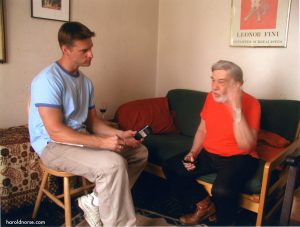
Jim Nawrocki is another San Francisco based poet who was a friend of Norse that will participate in the July 9 event. His poetry has appeared in A&U Magazine and Empty Mirror and he also regularly contributes essays and reviews to the Gay & Lesbian Review. Jim first met Harold in the early 2000s, resulting in a warm and supportive friendship between two gay poets from different generations.
Norse was notorious for exacting demands when it came to publishing his poetry, so it’s a testament to Nawrocki’s connection to Harold that he was instrumental in assembling the hundreds of poems that made up 2003’s collected poems–In the Hub of the Fiery Force–which spanned 70 years .
“At Albion” is a poem Jim wrote for a memorial collection which I published following Harold’s death in 2009. Evocative and graceful in its heartfelt sorrow, Jim conveys the impression and emotions which arose when visiting Norse’s home on Albion Street in San Francisco’s Mission District where the Beat poet lived for several decades.
At Albion
the steps up to your place
were blue hours in Tangier,
haunted Roman shadows,
a Paris hotel rank above
the street of the heart –
so many young men,
skin olive, gold, brown,
dragging with you
on white cigarettes
like a sacrament,
in Barcelona, Naples –
one more shaded room,
sleeping streets. A smile
from an afternoon corner:
Who is this American,
who speaks the mother tongue
so well?
Just near your door, one step
worn through, almost gone,
a broken Brooklyn, hanging,
like a page or a reverie
You’d warned me about it –
and each time I’d step over,
looking down into its eye.
Memory can swallow you up.
You meet me with your gaze
but your mouth wavers,
at play, undecided:
What language now,
to recite again
the beautiful words?
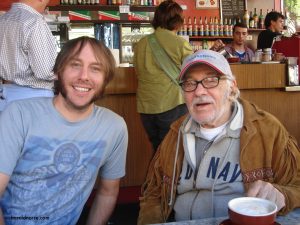
Tate Swindell is a poet, photographer, filmmaker, as well as the founder of Unrequited Records where he makes available poetry and spoken-word recordings by Beat authors such as Herbert Huncke and Jack Micheline.
Originally released in 1984 on cassette by Eddie Woods’ Ins & Outs Press, Harold Norse, Of Course… is a poetry reading which Harold gave in Amsterdam. In fine form, it remains one of the premier recordings of Harold reading his work.
Unrequited Records has made the original recording available as both a digital download and double record album. The vinyl release is a work of high craftsmanship featuring deluxe colored discs and a stunning gatefold collage of Harold’s snapshots. It’s a must for collectors of Beat era artifacts.
This once in a lifetime line up is a fitting way to continue the centennial celebration of Harold Norse. The Beat Museum was the site of Harold’s final poetry readings, so it is fitting that his spirit returns to North Beach. The event, which runs from 7-9 PM, is free.

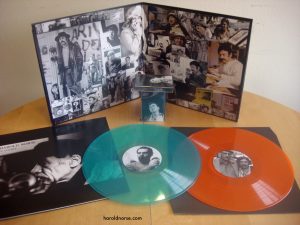

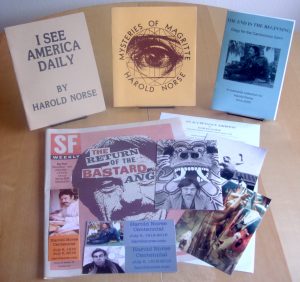 For those interested in obtaining copies of Harold Norse’s rare, out of print books, such as Beat Hotel, Memoirs of a Bastard Angel, and Hotel Nirvana, there is an online book sale happening during the month of May.
For those interested in obtaining copies of Harold Norse’s rare, out of print books, such as Beat Hotel, Memoirs of a Bastard Angel, and Hotel Nirvana, there is an online book sale happening during the month of May.